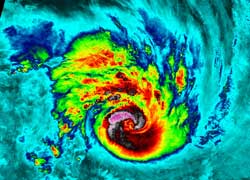NASA-NOAA's Suomi NPP Satellite Sees Powerful Cyclone Felleng

NPP IMAGE: NASA-NOAA's Suomi NPP satellite captured this false-colored night-time image of Cyclone Felleng during the night on Jan. 29, at 2109 UTC. The image clearly shows bands of thunderstorms wrapping into the eye of the storm. Felleng is west of northern Madagascar. Credit: William Straka, UWM/NASA/NOAA <br>
The Visible Infrared Imager Radiometer Suite (VIIRS) aboard NASA-NOAA's Suomi NPP satellite captured a night-time image of Cyclone Felleng when it was located east of Madagascar (4:09 p.m. EST/Jan. 30 at 12:09 a.m. local time, Madagascar).
The image was created at the University of Wisconsin-Madison and was false colored to reveal temperatures. The image shows powerful thunderstorms wrapping into the 20 nautical mile-wide (23 miles / 37 km) eye of the storm.
Felleng has intensified since Jan. 29 and as of 1500 UTC (10 a.m. EST) on Jan. 30, had maximum sustained winds near 115 knots (132.3 mph/213 kph). Felling is centered near 16.2 south and 52.6 east, about 400 nautical miles (460.3 miles/741 km) north-northwest of La Reunion Island.
Felleng is moving to the southwest at 13 knots (15 mph/24 kph) and is a threat to both Madagascar and La Reunion. The storm is creating dangerous seas, with wave heights up to 38 feet (11.5 meters).
La Reunion has already issued a Yellow Alert. For updates (in French), visit: http://www.meteo.fr/temps/domtom/La_Reunion/meteoreunion2/#
Felleng is turning towards the south and continues to intensify. The Joint Typhoon Warning Center expects Felleng to pass between La Reunion and Madagascar.
Text Credit: Rob Gutro
NASA's Goddard Space Flight Center, Greenbelt, Md.
Media Contact
All latest news from the category: Earth Sciences
Earth Sciences (also referred to as Geosciences), which deals with basic issues surrounding our planet, plays a vital role in the area of energy and raw materials supply.
Earth Sciences comprises subjects such as geology, geography, geological informatics, paleontology, mineralogy, petrography, crystallography, geophysics, geodesy, glaciology, cartography, photogrammetry, meteorology and seismology, early-warning systems, earthquake research and polar research.
Newest articles

A universal framework for spatial biology
SpatialData is a freely accessible tool to unify and integrate data from different omics technologies accounting for spatial information, which can provide holistic insights into health and disease. Biological processes…

How complex biological processes arise
A $20 million grant from the U.S. National Science Foundation (NSF) will support the establishment and operation of the National Synthesis Center for Emergence in the Molecular and Cellular Sciences (NCEMS) at…

Airborne single-photon lidar system achieves high-resolution 3D imaging
Compact, low-power system opens doors for photon-efficient drone and satellite-based environmental monitoring and mapping. Researchers have developed a compact and lightweight single-photon airborne lidar system that can acquire high-resolution 3D…





















